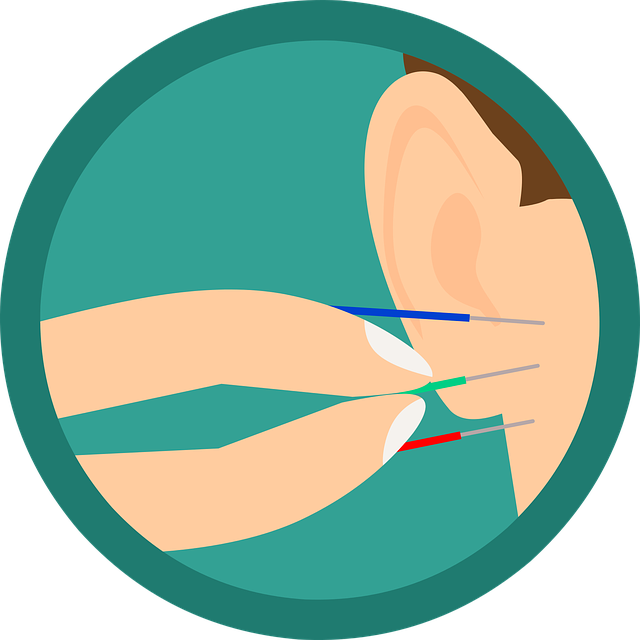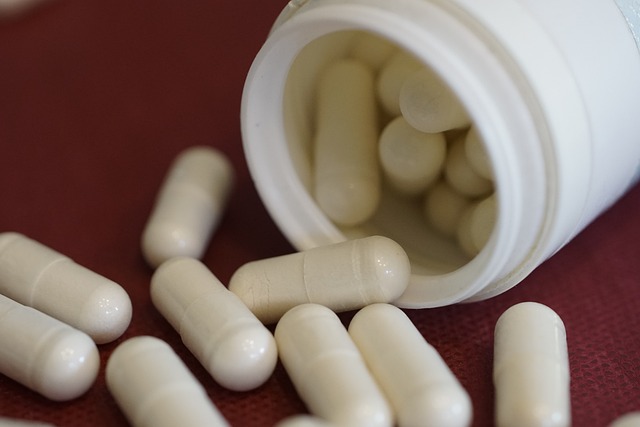Semaglutide Medication: A game-changer in diabetes management, Semaglutide mimics the natural hormone GLP-1 to improve glycemic control through enhanced insulin production and reduced glucagon release. Offered as a once-weekly injection, it also promotes significant weight loss. To ensure effectiveness, maintain a consistent administration routine and regularly monitor blood sugar levels. Potential side effects include nausea, vomiting, and constipation, which can be mitigated with proper hydration and dietary adjustments. A balanced diet, regular exercise, and stress management complement semaglutide therapy. Regular check-ups are vital for monitoring blood sugar levels and adjusting medications as needed. Semaglutide has shown remarkable results in reducing HbA1c, promoting weight loss, and improving cardiovascular outcomes.
“Discover how semaglutide, a groundbreaking glucagon-like peptide-1 receptor agonist (GLP-1RA), transforms diabetes care. This article explores its role as a powerful tool in managing blood sugar levels, delving into the mechanisms that make it effective. From understanding its action to integrating it into daily life, we guide you through the benefits and practical aspects of semaglutide therapy. Learn about monitoring blood sugar, potential side effects, dietary considerations, exercise integration, and long-term advantages, empowering you to optimize its efficacy.”
Understanding Semaglutide: A Glucagon-Like Peptide-1 Receptor Agonist

Semaglutide is a groundbreaking medication that has transformed diabetes management. As a Glucagon-Like Peptide-1 (GLP-1) receptor agonist, it mimics the natural hormone GLP-1, which plays a crucial role in regulating blood sugar levels. By activating these receptors, semaglutide stimulates insulin production and suppresses glucagon release, leading to improved glycemic control.
This medication is particularly notable for its once-weekly administration, offering convenience compared to daily injections. Its long-acting nature ensures consistent blood sugar management throughout the week. Additionally, studies have shown that semaglutide can lead to significant weight loss, making it a valuable tool in combating the metabolic complications often associated with diabetes.
How Semaglutide Helps Manage Diabetes: Mechanisms and Benefits

Semaglutide, a novel medication, has emerged as a powerful tool in the management of diabetes. Its primary mode of action involves mimicking the effects of the natural hormone GLP-1 (glucagon-like peptide-1), which plays a crucial role in regulating blood sugar levels. By activating specific receptors, semaglutide stimulates insulin secretion when blood glucose is high, while also suppressing glucagon release. This dual action helps to lower blood sugar levels effectively.
The benefits of semaglutide are multifaceted. It offers improved glycemic control, often leading to reduced HbA1c (hemoglobin A1c) levels compared to placebo or other diabetes medications. Additionally, it promotes weight loss, making it a valuable asset in combating the obesity epidemic often associated with diabetes. The medication’s once-weekly administration and reduced side effects further enhance its appeal, providing patients with a more convenient and potentially better tolerated diabetes management option.
Integrating Semaglutide into Your Daily Routine

Integrating Semaglutide into your daily routine can be a game-changer in managing diabetes. This medication, often prescribed for type 2 diabetes, works by mimicking a hormone that helps regulate blood sugar levels. To effectively incorporate semaglutide, start by understanding its administration schedule. Typically, it’s administered once weekly through injection, making it convenient to fit into your routine.
Create a consistent routine around your injections—for instance, setting aside the same time each week for self-administration. Keep track of your doses using a simple reminder app or calendar mark. Remember, consistency is key when managing diabetes, and integrating semaglutide into your daily life can significantly enhance blood sugar control over time.
Monitoring Blood Sugar Levels While on Semaglutide Therapy

Maintaining regular blood sugar monitoring is a vital part of managing diabetes, especially when on semaglutide medication. Semaglutide therapy has shown remarkable effectiveness in controlling blood glucose levels, but close observation is key to ensuring optimal results and preventing potential complications. Patients should aim for frequent testing throughout the day, as this injectable medication can cause rapid changes in sugar levels.
The ideal monitoring strategy may vary from person to person, but it typically involves checking before meals and at bedtime. It’s also advisable to track values after physical activity or when experiencing symptoms of low or high blood sugar. This data is invaluable for patients and healthcare providers alike, allowing them to fine-tune treatment plans, adjust semaglutide dosages, and ensure the patient stays within their target range.
Potential Side Effects and Management Strategies

Diabetes management involves various strategies, and one common approach is the use of semaglutide medication. While generally well-tolerated, this treatment isn’t without potential side effects. Common issues include nausea, vomiting, diarrhea, and constipation—often experienced during the initial stages of treatment. These symptoms usually subside as your body adjusts to the medication.
To manage these side effects, healthcare professionals recommend gradual dose escalation to allow your body time to adapt. Staying hydrated and maintaining a balanced diet can also help alleviate gastrointestinal discomfort. If symptoms persist or worsen, it’s essential to consult your doctor, who may offer alternative dosing strategies or explore other treatment options, ensuring the best care tailored to your needs.
Dietary Considerations for Optimal Semaglutide Efficacy

In managing diabetes with semaglutide medication, dietary considerations play a pivotal role in achieving optimal efficacy. A balanced diet that emphasizes whole foods, including lean proteins, healthy fats, and complex carbohydrates, can significantly enhance the drug’s effects. Fiber-rich meals, for instance, slow down glucose absorption, providing better blood sugar control throughout the day. Additionally, incorporating low-glycemic index foods can help stabilize blood sugar levels, which is crucial for those on semaglutide therapy.
Meal timing and frequency are also essential. Regular, consistent mealtimes allow the body to better regulate insulin production. Spacing meals appropriately with semaglutide injections ensures optimal absorption and peak action of the medication at mealtime, when blood sugar levels naturally rise after eating. Therefore, adhering to a structured dietary plan tailored to semaglutide therapy is an integral part of managing diabetes effectively.
Exercise and Lifestyle Changes to Support Diabetes Control

Regular exercise and adopting a healthy lifestyle play a pivotal role in managing diabetes, often working hand-in-hand with semaglutide medication to achieve optimal blood sugar control. Physical activity helps improve insulin sensitivity, allowing the body to use glucose more efficiently. This is particularly beneficial for individuals with type 2 diabetes, as it can reduce the need for insulin or other medications. Incorporating a variety of exercises like aerobic activities (e.g., walking, swimming), strength training, and flexibility workouts into your routine can significantly impact blood sugar levels.
Lifestyle changes are equally critical, focusing on balanced nutrition and maintaining a consistent eating schedule. A registered dietitian can offer personalized guidance on creating a meal plan that aligns with diabetes management goals. Additionally, stress management techniques should be explored, as stress hormones can negatively affect blood sugar. Integrating these lifestyle adjustments alongside semaglutide treatment can lead to improved overall health and well-being for those living with diabetes.
Regular Check-ups: Ensuring Safe and Effective Treatment

Regular check-ups are a cornerstone in managing diabetes, especially with the use of semaglutide medication. These visits allow healthcare professionals to closely monitor patients’ blood sugar levels and overall health, ensuring that the treatment plan remains effective and safe. During these appointments, doctors can adjust medications, provide guidance on lifestyle changes, and detect any potential complications early on.
The frequency of check-ups may vary depending on individual needs, but they are crucial for maintaining optimal diabetes control. Regular monitoring helps in understanding how one’s body responds to semaglutide and other treatments, enabling healthcare providers to make informed decisions tailored to the patient’s unique circumstances.
Long-term Benefits of Semaglutide in Diabetes Management

Semaglutide, a medication that has gained significant attention in diabetes management, offers long-term benefits for patients with type 2 diabetes. Its primary role is to mimic the effects of the hormone GLP-1 (glucagon-like peptide-1), which stimulates insulin production and suppresses glucagon release. This dual action helps lower blood sugar levels effectively.
Over time, semaglutide has shown remarkable results in reducing HbA1c (hemoglobin A1c) levels, a crucial marker for long-term blood sugar control. It also promotes weight loss, which is a significant advantage as obesity is often associated with type 2 diabetes. Additionally, studies suggest that continued use of semaglutide can lead to improved cardiovascular outcomes, further emphasizing its value as a part of a comprehensive diabetes care plan.
